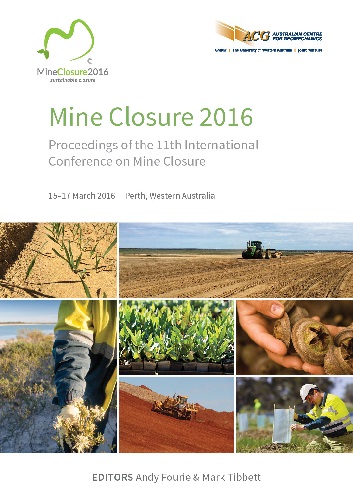Ecological research needed to manage risk and meet rising standards in mining rehabilitation

|
Authors: Miller, B |
DOI https://doi.org/10.36487/ACG_rep/1608_0.2_Miller
Cite As:
Miller, B 2016, 'Ecological research needed to manage risk and meet rising standards in mining rehabilitation', in AB Fourie & M Tibbett (eds), Mine Closure 2016: Proceedings of the 11th International Conference on Mine Closure, Australian Centre for Geomechanics, Perth, pp. 13-16, https://doi.org/10.36487/ACG_rep/1608_0.2_Miller
Abstract:
Ecological sciences can assist mine planning and management on the way to effective rehabilitation and closure in a number of distinct ways. The identification of likely environmental impacts is a routine application that aids planning. Extending this to assessing the likely complexity of rehabilitation needs may be an equally valuable aid for risk-identification and mitigation, but is not at all routine. The identification of reference target ecosystems, the design of approaches to sample, assess and define these, and then to monitor rehabilitation trajectory towards them are elements of best practice. While these can significantly improve rehabilitation planning and effectiveness, they are often not applied in a way that enables this potential. Lastly, improving technical capacity to deliver required rehabilitation outcomes is the broadest area of potential benefit to closure management. Investing in environmental science may seem counterintuitive for a mining company but there are many potential benefits.
References:
DeJong, JT, Tibbett, M & Fourie, A 2015, ‘Geotechnical systems that evolve with ecological processes’, Environmental Earth Science, vol. 73, pp. 1067–1082.
Erskine, PD, Mulligan, DR, Olsen, MF, Kirsch, B & Roe, P 2007, ‘Completion criteria for rehabilitated forest ecosystems on mined land – should they be based on unmined reference sites?’, in AB Fourie, M Tibbett & JV Wiertz (eds), Proceedings of the Second International Seminar on Mine Closure, Australian Centre for Geomechanics, Perth, pp. 211–216.
Garrah, KL & Campbell, D 2011, ‘Reference conditions for rehabilitating mine stockpiles as novel upland ecosystems in Canada’s subarctic’, in AB Fourie, M Tibbett & A Beersing (eds), Proceedings of the Sixth International Conference on Mine Closure, vol. 1: Mine Site Reclamation, Australian Centre for Geomechanics, Perth, pp. 11–17.
Kirkman, LK, Barnett, A, Williams, BW, Hiers, JK, Pokswinski, SM & Mitchell, RJ 2013, ‘A dynamic reference model: a framework for assessing biodiversity restoration goals in a fire-dependent ecosystem’, Ecological Applications, vol. 23, no. 7, pp. 1574–1587.
Lamb, D, Erskine, PD & Fletcher, A 2015, ‘Widening gap between expectations and practice in Australian minesite rehabilitation’, Ecological Management & Restoration, vol. 16, no. 3, pp. 186–195.
Tibbett, M (ed.) 2015, Mining in Ecologically Sensitive Landscapes, CRC Press, p. 276.
Williams, AV, Nevill, PG & Krauss, SL 2014, ‘Next generation restoration genetics: applications and opportunities’, Trends in Plant Science, vol. 19, no. 8, pp. 529–537.
© Copyright 2025, Australian Centre for Geomechanics (ACG), The University of Western Australia. All rights reserved.
View copyright/legal information
Please direct any queries or error reports to repository-acg@uwa.edu.au
View copyright/legal information
Please direct any queries or error reports to repository-acg@uwa.edu.au